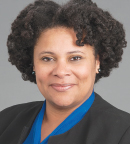
Karen M. Winkfield, MD, PhD
IN 2017, ASCO issued its recommendations for addressing the oncology care needs of sexual and gender minority cancer survivors and the unique challenges they face.1 There are myriad reasons for cancer disparities in this population compared to heterosexual cisgender cancer survivors, including discrimination; gaps in health-care access due to health insurance costs and a lack of trust in the physician-patient relationship; and a greater prevalence of cancer-related risk factors, such as obesity and alcohol, tobacco, and substance use.
To reduce cancer disparities in the sexual and gender minority population, including individuals who are lesbian, gay, bisexual, transgender, queer/questioning, and intersex (LGBTQI), ASCO is recommending the development of greater patient education and support, workforce diversity, quality improvement strategies, policy solutions, and research strategies. (For a video presentation of ASCO’s recommendations, visit www.asco.org/advocacy-policy/asco-in-action/ sexual-and-gender-minorities-statement-overview-video-nov-2017.)
GUEST EDITOR
Adolescent and Young Adult Oncology explores the unique physical, psychosocial, social, emotional, sexual, and financial challenges adolescents and young adults with cancer face. The column is guest edited by Brandon Hayes-Lattin, MD, FACP, Professor of Medicine and Medical Director of the Adolescent and Young Adult Oncology Program at the Knight Cancer Institute at Oregon Health and Science University in Portland, Oregon.For adolescents and young adults (AYAs) with cancer who identify as sexual and gender minority, overcoming the barriers to quality care can be more daunting than it is for their older counterparts due to their fear of “coming out” to health-care providers. A literature review by Hafeez et al of health-care disparities among lesbian, gay, bisexual, and transgender youths included a study showing that 68% of sexual minority youths reported not discussing their sexual orientation with their clinicians, and 90% had reservations about reporting their sexual orientation to their health-care providers. Another study in the review found that the disclosure of sexual orientation and the provider’s attitude were important influencing factors that negatively affected this population’s experiences with health-care delivery.2

Brandon Hayes-Lattin, MD, FACP
“Having cultural humility is important to providing high-quality cancer care for all patients. Bringing a sense of humility into every clinical encounter assures patients they are in a safe space and allows individuals to self-identify their sexual orientation and gender. This can be especially important for AYA patients,” said Karen M. Winkfield, MD, PhD, former Chair of ASCO’s Health Disparities Committee and Director of Hematologic Radiation Oncology and the Office of Cancer Health Equity at Wake Forest Baptist Health in Winston-Salem, North Carolina.
The ASCO Post talked with Dr. Winkfield about the unique health-care challenges AYA sexual and gender minority survivors face; how oncologists can provide safe environments for these survivors to disclose their sexual orientation; and the institutional changes that are needed to improve cancer care for young lesbian, gay, bisexual, and transgender/ transsexual cancer survivors.
“Having cultural humility is important to providing high-quality cancer care for all patients.”— Karen M. Winkfield, MD, PhD
Tweet this quote
Discrimination and Cancer Survival Outcome
How does fear of discrimination in accessing health care impact survival outcome in sexual and gender minority youth with cancer?
Wanting to avoid a potentially uncomfortable encounter with a health-care provider can lead to delays in getting cancer prevention screenings, and as a result, cancers are often diagnosed at later stages when they are more difficult to treat and cure. Moreover, we know that human papillomavirus (HPV)-related cancers, including cervical and oropharyngeal cancers, are on the rise in the sexual and gender minority population, and these cancers are also increasing in AYAs. Lack of information may delay screening and treatment.
For example, a lesbian woman may not think she needs to be screened for cervical cancer because she is not having sexual intercourse with a man, and, therefore, elects to forgo regular Pap tests. A young man who has sex with men might not know he is at an increased risk for anal HPV if he has unprotected sex, which increases his risk for anal cancer. If his sexual orientation is not disclosed to his doctor, he may not have a discussion regarding the risks/benefits of an anal Pap test, which screens for abnormal anal cells and detects precancerous lesions.
Patients already diagnosed with cancer may not disclose their sexual orientation if they sense any bias from the oncologist or the medical staff. This may impact the physician/patient trust relationship and can contribute to patients not adhering to or completing therapy.
We have to develop routines in our practices that encourage inclusion and a welcoming environment for young sexual and gender minority patients. We can do that through patient education materials that include representation of sexual and gender minority patients, prominently displaying nondiscrimination statements that include gender identity and sexual orientation, providing gender-neutral bathrooms in cancer care facilities, and implementing policies addressing end-of-life care that respect the patient’s social context and his or her choice of burial and death rituals. We also need to change health-care intake forms to allow patients to self-identify their sexual orientation and gender identity.
Ensuring Quality Cancer Care
What can oncologists do to ensure that their AYA LGBTQI patients are getting comprehensive quality care?
“Wanting to avoid a potentially uncomfortable encounter with a health-care provider can lead to delays in getting cancer prevention screenings….”— Karen M. Winkfield, MD, PhD
Tweet this quote
We need to make sure that every patient who walks through our door receives high-quality, comprehensive cancer care. One way to do that is to not make cultural assumptions about patients’ lifestyles or the relationships they have with people they bring to their therapy appointments.
For example, during an initial consultation with one of my male patients, he was accompanied by a woman. After introducing myself, I asked him, “Who is with you today?” And he introduced his guest as his best friend who has been by his side through the start of his diagnosis. I then asked whom he lives with, and he shared that he lives with his same-sex partner.
As providers, we shouldn’t assume that because a male and female walk into the exam room, they are husband and wife. Simple questions like these open the door to allow AYA sexual and gender minority patients to feel comfortable self-identifying their sexual orientation and gender and provide a welcoming health-care environment for everyone.
Gathering Information
When is the most appropriate time to capture the distinctive needs of this population and consider their unique concerns? Is it during patient registration?
We need more input from the sexual and gender minority community about when they prefer to disclose their sexual orientation and gender identity to the medical staff. Perhaps it is gathered as part of the patient intake process during patient registration, or maybe it is done during the initial workup with the physician.
“The bottom line is that the practitioner and the institution are ultimately responsible for creating a welcoming environment for patients.”— Karen M. Winkfield, MD, PhD
Tweet this quote
Every provider has a different way of assessing the social history of his or her patients. What is most important is that whenever the information is taken and whether it is gathered by a nurse or a physician, the questions relating to sexual orientation and gender identity are somehow interpolated into the routine fabric of the clinical assessment and done in a safe environment. The onus is on the provider to make sure these discussions are free of bias. The bottom line is that the practitioner and the institution are ultimately responsible for creating a welcoming environment for patients.
Physician Cultural Competency Training
What has to happen institutionally to improve physician training in health-care disparities in sexual and gender minority patients?
A recent Institute of Medicine report found extensive evidence that many providers are not trained to provide care for sexual and gender minority patients,3 so training about the health risks and health concerns of young sexual and gender minority patients absolutely needs to happen in medical school. It also needs to take place for those already in practice who may not be adequately informed about these patients’ health-care concerns and their barriers to care.
In my view, it is not enough to train medical students, fellows, and residents in cultural competency to address physician bias. We may need to reeducate oncologists who have been practicing for many years as well, particularly those in academic centers since they model behaviors for the next generation of clinicians. Cultural literacy requires all health-care personnel to understand and respond effectively to the cultural and language needs of the patient throughout the cancer care continuum and to provide care in an empathetic and nonjudgmental way.
ASCO University offers a free slide-based course on Cultural Competence for Oncology Practice (https://university.asco.org/cultural-competence-oncology-practice) to help oncology care providers enhance their interactions with patients from diverse backgrounds. The principles certainly apply to sexual and gender minority populations as well. Perhaps additional training modules could be created to specifically focus on sexual and gender minority patients, highlighting the unique challenges AYA patients may face during their cancer journey.
“It is not enough to train medical students, fellows, and residents in cultural competency to address physician bias. We may need to reeducate oncologists who have been practicing for many years as well….”— Karen M. Winkfield, MD, PhD
Tweet this quote
Reducing Cancer Care Disparities
Can ASCO’s recommendations for reducing cancer disparities among sexual and gender minority populations be adapted to apply to younger sexual and gender minority patients?
Yes, absolutely. These are just first steps to acknowledging and recognizing the challenges sexual and gender minority patients face, and there is a need to further refine the recommendations to specifically address the concerns of subsets of patient populations, particularly AYA patients, because they are so underserved already. We know, for example, that LGBTQI youth have an increased risk of depression and are more likely to be involved in high-risk sexual behaviors and substance use at an earlier age than their heterosexual counterparts.
To adequately understand the health-care challenges faced by this population, their health outcomes, and effective interventions to improve outcomes, as well as to establish standards of care, we need more research. In 2016, the National Institutes of Health (NIH) designated sexual and gender minorities as a health disparity population for NIH research.
ASCO is asking that sexual and gender minority status be required data in cancer registries and clinical trials and that in addition to the NIH, other organizations fund research in cancer prevention, health promotion, and end-of-life/chronic illness experiences of sexual and gender minority patients. ASCO is committed to promoting increased research on this issue through its programs, including the Conquer Cancer Foundation and ASCO journals.
To provide true personalized care for underserved populations, we need to treat not just the tumor, but the whole patient as well. We need to understand what each patient needs for the best chance of surviving cancer—and to survive it well. ■
DISCLOSURE: Dr. Winkfield reported no conflicts of interest.
REFERENCES
1. Griggs J, Maingi S, Blinder V, et al: American Society of Clinical Oncology Position Statement: Strategies for reducing cancer health disparities among sexual and gender minority populations. J Clin Oncol 35:2203-2208, 2017.
2. Hafeez H, Zeshan M, Tahir M, et al: Health care disparities among lesbian, gay, bisexual, and transgender youth: A literature review. Cureus 9:e1184, 2017.
3. Institute of Medicine: The health of lesbian, gay, bisexual, and transgender people: Building a foundation for better understanding. Washington, DC; The National Academies Press; 2011. Available at www.nap.edu. Accessed January 14, 2019.

